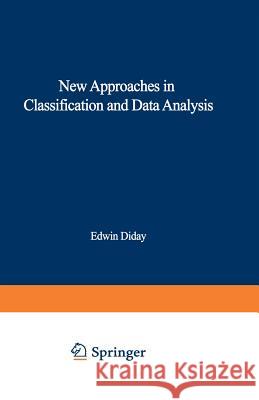New Approaches in Classification and Data Analysis » książka



New Approaches in Classification and Data Analysis
ISBN-13: 9783540584254 / Angielski / Miękka / 1994 / 693 str.
New Approaches in Classification and Data Analysis
ISBN-13: 9783540584254 / Angielski / Miękka / 1994 / 693 str.
(netto: 383,36 VAT: 5%)
Najniższa cena z 30 dni: 385,52
ok. 22 dni roboczych
Dostawa w 2026 r.
Darmowa dostawa!
This volume describes the analysis and processing of structural or quantitative data. It emphasizes classification methods and new algorithms, as well as applications in various related fields. It consists of survey papers in addition to research results.
Classification and Clustering: Problems for the Future.- From classifications to cognitive categorization: the example of the road lexicon.- A review of graphical methods in Japan—from histogram to dynamic display.- New Data and New Tools: A Hypermedia Environment for Navigating Statistical Knowledge in Data Science.- On the logical necessity and priority of a monothetic conception of class, and on the consequent inadequacy of polythetic accounts of category and categorization.- Research and Applications of Quantification Methods in East Asian Countries.- Algorithms for a geometrical P.C.A. with the L1-norm.- Comparison of hierarchical classifications.- On quadripolar Robinson dissimilarity matrices.- An Ordered Set Approach to Neutral Consensus Functions.- From Apresjan Hierarchies and Bandelt-Dress Weak hierarchies to Quasi-hierarchies.- Spanning trees and average linkage clustering.- Adjustments of tree metrics based on minimum spanning trees.- The complexity of the median procedure for binary trees.- A multivariate analysis of a series of variety trials with special reference to classification of varieties.- Quality control of mixture. Application: The grass.- Mixture Analysis with Noisy Data.- Locally optimal tests on spatial clustering.- Choosing the Number of Clusters, Subset Selection of Variables, and Outlier Detection in the Standard Mixture-Model Cluster Analysis.- An examination of procedures for determining the number of clusters in a data set.- The gap test: an optimal method for determining the number of natural classes in cluster analysis.- Mode detection and valley seeking by binary morphological analysis of connectivity for pattern classification.- Interactive Class Classification Using Types.- K-means clustering in a low-dimensional Euclidean space.- Complexity relaxation of dynamic programming for cluster analysis.- Partitioning Problems in Cluster Analysis: A Review of Mathematical Programming Approaches.- Clusters and factors: neural algorithms for a novel representation of huge and highly multidimensional data sets.- Graphs and structural similarities.- A generalisation of the diameter criterion for clustering.- Percolation and multimodal data structuring.- Classification and Discrimination Techniques Applied to the Early Detection of Business Failure.- Recursive Partition and Symbolic Data Analysis.- Interpretation Tools For Generalized Discriminant Analysis.- Inference about rejected cases in discriminant analysis.- Structure Learning of Bayesian Networks by Genetic Algorithms.- On the representation of observational data used for classification and identification of natural objects.- Alternative strategies and CATANOVA testing in two-stage binary segmentation.- Alignment, Comparison and Consensus of Molecular Sequences.- An Empirical Evaluation of Consensus Rules for Molecular Sequences.- A Probabilistic Approach To Identifying Consensus In Molecular Sequences.- Applications of Distance Geometry to Molecular Conformation.- Classification of aligned biological sequences.- Use of Pyramids in Symbolic Data Analysis.- Proximity Coefficients between Boolean symbolic objects.- Conceptual Clustering in Structured Domains: A Theory Guided Approach.- Automatic Aid to Symbolic Cluster Interpretation.- Symbolic Clustering Algorithms using Similarity and Dissimilarity Measures.- Feature Selection for Symbolic Data Classification.- Towards extraction method of knowledge founded by symbolic objects.- One Method of Classification based on an Analysis of the Structural Relationship between Independent Variables.- The Integration of Neural Networks with Symbolic Knowledge Processing.- Ordering of Fuzzy k-Partitions.- On the Extension of Probability Theory and Statistics to the Handling of Fuzzy Data.- Fuzzy Regression.- Clustering and Aggregation of Fuzzy Preference Data: Agreement vs. Information.- Rough Classification with Valued Closeness Relation.- Representing proximities by network models.- An Eigenvector Algorithm to Fit lp-Distance Matrices.- A non linear approach to Non Symmetrical Data Analysis.- An Algorithmic Approach to Bilinear Models for Two-Way Contingency Tables.- New Approaches Based on Rankings in Sensory Evaluation.- Estimating failure times distributions from censored systems arranged in series.- Calibration Used as a Nonresponse Adjustment.- Least Squares Smoothers and Additive Decomposition.- High Dimensional Representations and Information Retrieval.- Experiments of Textual Data Analysis at Electricité de France.- Conception of a Data Supervisor in the Prospect of Piloting Management Quality of Service and Marketing.- Discriminant Analysis Using Textual Data.- Recent Developments in Case Based Reasoning: Improvements of Similarity Measures.- Contiguity in discriminant factorial analysis for image clustering.- Exploratory and Confirmatory Discrete Multivariate Analysis in a Probabilistic Approach for Studying the Regional Distribution of Aids in Angola.- Factor Analysis of Medical Image Sequences (FAMIS): Fundamental principles and applications.- Multifractal Segmentation of Medical Images.- The Human Organism—a Place to Thrive for the Immuno-Deficiency Virus.- Comparability and usefulness of newer and classical data analysis techniques. Application in medical domain classification.- The Classification of IRAS Point Sources.- Astronomical classification of the Hipparcos input catalogue.- Group identification and individual assignation of stars from kinematical and luminosity parameters.- Specific numerical and symbolic analysis of chronological series in view to classification of long period variable stars.- Author and Subject Index.
1997-2025 DolnySlask.com Agencja Internetowa
KrainaKsiazek.PL - Księgarnia Internetowa









